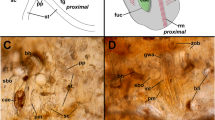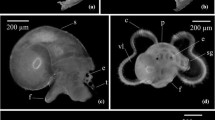Abstract
Evolutionary developmental biology has focused almost exclusively on multicellular organisms, but there are other relevant levels of biological organization that have remained largely neglected. Animal colonies are made up of multiple physiologically integrated and genetically identical units called zooids that are each homologous to solitary, free-living animals. Siphonophores, a group of pelagic hydrozoans (Cnidaria), have the most complex colony-level organization of all animals. Here the colony-level development of five siphonophore species, strategically sampled across the siphonophore phylogeny, is described from specimens collected using deep-sea submersibles and by self-contained underwater breathing apparatus diving. These species include three cystonects, Bathyphysa sibogae, Rhizophysa filiformis, and Rhizophysa eysenhardti, and two “physonects”, Agalma elegans and Nanomia bijuga. These data, together with previous findings, are analyzed in a phylogenetic framework to reconstruct key features of the history of colony-level organization and development in the Siphonophora. It is shown that gonodendra and gastrozooids of the examined cystonects arise as independent buds directly on the stem, whereas probud subdivision (the origin of feeding, reproductive, and other zooids from a single bud) is a synapomorphy of the Codonophora. The origin of probud subdivision is associated with the origin of cormidia as integrated units of colony organization, and may have allowed for greater morphological and ecological diversification in the Codonophora relative to the Cystonectae. It is also found that symmetry is labile in siphonophores, with multiple gains and/or losses of directional asymmetry in the group. This descriptive work will enable future mechanistic and molecular studies of colony-level development in the siphonophores.







Similar content being viewed by others
References
Beklemishev WN (1969) Principles of comparative anatomy, vol 1. Promorphology. Oliver and Boyd, Edinburgh
Bonner J (2001) First signals: the evolution of multicellular development. Princeton University Press, Princeton
Buss L (1987) The evolution of individuality. Princeton University Press, Princeton
Carré C, Carré D (1993) Ordre des Siphonophores. In: Doumenc D (ed) Traité de Zoologies: Anatomie, Systematique, Biologie, vol 3(2). Masson, Paris, pp 523–596
Chun C (1885) Über die cyklische Entwickelung der Siphonophoren. Sitz Ber K Preuss Akad Wiss Berl 1885:511–529
Dunn CW (2005) The complex colony-level organization of the deep-sea siphonophore Bargmannia elongata (Cnidaria, Hydrozoa) is directionally asymmetric and arises by the subdivision of pro-buds. Dev Dyn 234:835–845
Dunn CW, Pugh PR, Haddock SHD (2005) Molecular phylogenetics of the Siphonophora (Cnidaria), with implications for the evolution of functional specialization. Syst Biol 54:916–935
Gegenbaur C (1853) Beiträge zur näheren Kenntniss der Schwimmpolypen (Siphonophoren). Arch Naturgesch 5:285–344
Haddock SHD, Dunn CW, Pugh PR (2005) A reexamination of siphonophore terminology and morphology, applied to the description of two new prayine species with remarkable bio-optical properties. J Mar Biol Assoc UK 85:695–707
Haeckel E (1869) Zur Entwickelungsgeschichte der Siphonophoren. Natuurk Verh Prov Utrechtsh Genoots 6:1–120
Hamner WM (1975) Underwater observations of blue-water plankton: logistics, techniques, and safety procedures for divers at sea. Limnol Oceanogr 20:1045–1051
Kawamura T (1910) “Bozunira” and “Katsuwo no Eboshi” Rhizophysa and Physalia. Dobutz Z Tokyo 22:445–454
Kawamura T (1911) “Shidarezakura Kurage” and “Nagayoraku Kurage” Cupulita picta Metschnikoff and Agalmopsis elegans Sars. Dobutz Z Tokyo 23:359–363
Leloup E (1936) Siphonophores calycophorides (suite) et physophorides provenant des campagnes du Prince Albert Ier de Monaco. Res Camp Sci Monaco 93:3–36
Maynard Smith J, Szathmáry E (1995) Major transitions in evolution. Oxford University Press, Oxford
Pugh PR (1984) The diel migrations and distributions within a mesopelagic community in the north east Atlantic. 7. Siphonophores. Prog Oceanogr 13:461–489
Pugh PR (2003) A revision of the family Forskaliidae (Siphonophora, “Physonectae”). J Nat Hist 37:1281–1327
Pugh PR, Harbison GR (1986) New observations on a rare physonect siphonophore, Lychnagalma utricularia (Claus, 1879). J Mar Biol Assoc UK 66:695–710
Robison BH (1995) Light in the ocean’s midwaters. Sci Am 273:60–64
Schneider KC (1896) Mittheilungen über Siphonophoren. II. Grundriss der organization der Siphonophoren. Zool Jahrb Abt Anat Ontog Tiere 9:571–664
Totton AK (1954) Siphonophora of the Indian Ocean. Discov Rep 27:1–162
Totton AK (1956) Development and metamorphosis of the larva of Agalma elegans (Sars) (Siphonophora “Physonectae”). Pap Mar Biol Oceanogr 3(Suppl):239–241
Totton AK (1960) Studies on Physalia physalis. Part 1. Natural history and morphology. Discov Rep 30:301–368
Totton AK (1965) A synopsis of the siphonophora. British Museum of Natural History, London
Youngbluth M (1984) Manned submersibles and sophisticated instrumentation: tools for oceanographical research. In: “Proceedings of SUBTECH ’83 Symposium.” Society for Underwater Technology, London, pp 335–344
Acknowledgements
This work was supported by a mini-PEET grant from the Society for Systematic Biology, a National Science Foundation Graduate Research Fellowship, and a National Science Foundation (NSF) doctoral dissertation improvement grant (DEB-0408014). Thanks to S.H.D. Haddock, J. Godfrey, L. Madin, C. Sardet, and C. Carré for their assistance with collecting siphonophores. E. Edwards provided valuable comments on the text. Special thanks to P. Pugh for making his specimens available for this work, for providing feedback on the manuscript, for checking some of the observations presented here, and, in particular, for our many illuminating conversations.
Author information
Authors and Affiliations
Corresponding author
Additional information
Communicated by M. Q. Martindale
Rights and permissions
About this article
Cite this article
Dunn, C.W., Wagner, G.P. The evolution of colony-level development in the Siphonophora (Cnidaria:Hydrozoa). Dev Genes Evol 216, 743–754 (2006). https://doi.org/10.1007/s00427-006-0101-8
Received:
Accepted:
Published:
Issue Date:
DOI: https://doi.org/10.1007/s00427-006-0101-8




